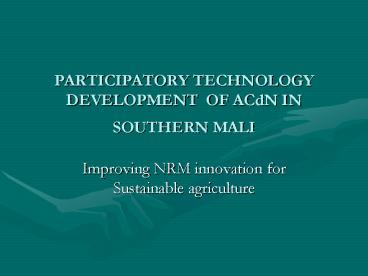PARTICIPATORY TECHNOLOGY DEVELOPMENT OF ACdN IN SOUTHERN MALI - PowerPoint PPT Presentation
1 / 27
Title:
PARTICIPATORY TECHNOLOGY DEVELOPMENT OF ACdN IN SOUTHERN MALI
Description:
PARTICIPATORY TECHNOLOGY DEVELOPMENT OF ACdN IN SOUTHERN MALI ... 3000 FCFA/ha (subvention) Phase I. 5000 FCFA/ha Phase II : Farmers won't accept? ... – PowerPoint PPT presentation
Number of Views:602
Avg rating:3.0/5.0
Title: PARTICIPATORY TECHNOLOGY DEVELOPMENT OF ACdN IN SOUTHERN MALI
1
PARTICIPATORY TECHNOLOGY DEVELOPMENT OF ACdN IN
SOUTHERN MALI
- Improving NRM innovation for Sustainable
agriculture
2
Outline
- INTRODUCTION
- CONTEXT OF PTD
- ACdN PTD APPROACH
- OUTCOMES OF THE APPROACH
- WEAKNESSES OF THE APPROACH
- IMPROVING NRM INNOVATION FOR AGRICULTURAL
SUSTAINABILITY
3
INTRODUCTION
- Increased production of cotton
- 220 996 tons in 1991
- 459 792 tons in 2000
- Cotton yields
- 1991 1227 kg/ha
- 2000 1000 kg/ha
- Cotton area
- 1990/91 205 311 ha
- 1999/00 482 293 ha
- Sustainability of cotton-based systems??
4
INTRODUCTION (Continued)
5
Introduction (continued)
- Soil degradation
- Acidification
- Erosion ( ancient cotton belt)
- Many SWC technologies are available (stone
lines, mulch, living fences, improved fallows,
ridge tillage..) - But low level of adoption (LAE lt50, 40 type A,
10 type B).
6
CONTEXT OF PTD IN MALI-SUD
- Before 1980 (Diffusion model)
- Researchers (IER)
- Extension (CMDT)
- Village-based farmer associations
7
CONTEXT OF PTD IN MALI-SUD (Continued)
- After 1980 (FSRExtension model)
- Researchers
- (IER)
- Extension Farmers
- (CMDT) (Communities)
8
CONTEXT OF PTD IN MALI-SUD (Continued)
- 1978 Natural resource management problems
(Fonsebougou) - Soil erosion/Overgrazing/ Logging/Bushfire
- Land clearing
- 1982 Development of a soil conservation model
with 4 farmers at katio watershed (Fonsebougou)
9
CONTEXT OF PTD IN MALI-SUD (Continued)
- 1984 Water conservation experiment in Kaniko
- Village based approach (AV)
- 1985 WCE at Try I and Try II
- 1986 SWC extension project in CMDT
- Choice of villages (few villages, use of local
resources) - Training extension staff
- Sensitizing, animation and training of
communities
10
CONTEXT OF PTD IN MALI-SUD (Continued)
- SWC have concerned a limited number of farmers
- Farmers were aware of the threats soil erosion
and degradation to their livelihoods - They lack means and motivation for making SWC a
priority because they dont get short term
benefits from the adoption of these technologies - There is a need to introduce incentives to
increase benefits for farmers
11
CONTEXT OF PTD IN MALI-SUD (Continued)
- Research should monitor and analyze extension
activities, propose changes according rainfall,
soil, ethnic , farming system characteristic, - find solutions to technical problems face by
extension - Test of practical approach of gestion des
terroirs
12
ACdN TECHNOLOGY DEVELOPMENT APPROACH
- ACdN technology as a SW management technology
with short term benefits - A Commodity technology development
(LABOSEP-CIRAD) - A Farming system and extension approach (FSRNRM
) - NGOs approach (AMEDD)
13
A Commodity technology development
(LABOSEP-CIRAD)
- Researcher managed trials (1994-2001) have shown
that positive impacts on soil physical
properties of ACdN are - - Reduced run-off at plot level by 20 to 40
- - Deeper wetting front from 1.2 to 20m
- - Increase soil water content (10 t0 30 vol).
- ACdN technology alone increased also the yield of
crops by 30 and in combination with mineral
fertilizers the yield increase was 50.
14
Crop Monetary Income of ACdN adoption at farmer
level
15
A farming system and Extension approach
(FSRNRM-INTERCRSP)
- FSENRM (CMDT)
- Training of village-based farmer association in
ACdN implementation - FSRNRM (OHVN)
- Farmers to farmers visits (InterCRSP-NRM)
- Farmers managed trials based on rural household
resource endowments (A, B, C and D)
16
Yields of sorghum and maize under farmers
managed trials
17
ACdN TECHNOLOGY DEVELOPMENT APPROACH
18
A Commodity technology development approach
- Konobougou (LABOSEP-CIRAD)
- Diagnosis by technical team
- 5000 FCFA/ha
- Oumarbougou (AMED)
- Same approach
- 3000 FCFA/ha (subvention) Phase I
- 5000 FCFA/ha Phase II Farmers wont accept?
- Increasing demand for ACdN but not satisfied?
19
Adoption profile of ACdN Konobougou
20
OUTCOMES OF THE APPROACH
- AWARENESS OF ACTORS
- ACTORS ARE ENGAGED IN A SOCIAL LEARNING PROCESS
- FARMERS ARE WILLING TO INVEST
21
WEAKNESSES OF THE ACdN TECHOLOGY APPROACH
- Lack of active farmer participation
- No two-way sharing of information among farmers,
researchers and extension - No capacity building for socializing lessons
learned - Overcoming socio-economical aspects
- No collective decision making and concerted action
22
IMPROVING NRM INNOVATION FOR AGRICULTURAL
SUSTAINABILITY
- New context
- Moving from a technical phase, economical phase
to policy phase (Land use a contested activity
with multiple stakeholders) - An interactive perspective for technological
innovation requires - Building platforms for dialogue and interactions
among actors,
23
IMPROVING NRM INNOVATION FOR AGRICULTURAL
SUSTAINABILITY (Continued)
- Enhanced innovative performance (facilitating the
interactive process, - A framework for evaluating the process
- Empowerment of farmers to exert countervailing
power in the policy games - Farmers to farmers visits, farmers field
schools and tools as real alternatives to
conventional thinking about diffusion and
transfer of technology
24
IMPROVING NRM INNOVATION FOR AGRICULTURAL
SUSTAINABILITY (Continued)
Crucial outcomes from interaction
are Reciprocity and trust, Negotiated
agreement, Conflict management, Social learning
Overcoming social dilemmas, Collective decision
making and Concerted action.
25
(No Transcript)
26
Conventional Flow of Information an Materials
27
Conceptual View of Technology Development and
Transfer/Diffusion































